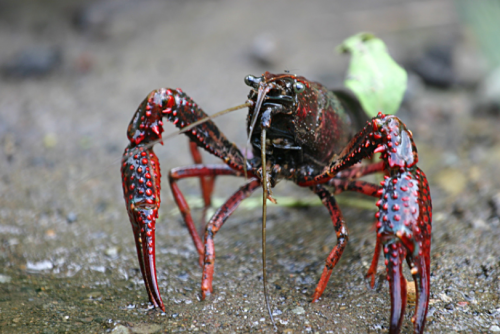Despite conservation efforts, the red swamp crayfish has established a foothold in Michigan
National Invasive Species Awareness Week, Part 5: More than 5,000 red swamp crayfish have been removed, but battle continues.

National Invasive Species Awareness Week this year is Feb. 26 to March 2, 2018. The goal is to draw attention to invasive species and what individuals can do to stop the spread and introduction of them. This effort is sponsored by a diverse set of partners from across the country. To increase awareness of Michigan’s invasive species, Michigan State University Extension and Michigan Sea Grant are publishing a series of articles featuring resources and programs in our state working on invasive species issues.
Today’s article brings an update on the invasive red swamp crayfish (Procambarus clarkii). Prior to July 14, 2017, no live red swamp crayfish had been found in Michigan although carcasses were found at a popular fishing site on the Grand River and Lake Macatawa in 2013 and 2015, respectively. However, in July 2017 red swamp crayfish were confirmed living in large numbers in a storm water retention pond in Oakland County as well as in Sunset Lake in Kalamazoo County.
According to the Midwest Invasive Species Information Network (MISIN) this invasive crustacean can be up to 5 inches long including claws, although the Michigan Department of Natural Resources found individuals nearly 9 inches in 2017. Red swamp crayfish have a dark red body, claws with spiky, bright red bumps and a black wedge-shaped stripe on their underside.
Spreading through the U.S.
The red swamp crayfish is native to the Mississippi River drainage and the Gulf Coast and likely came to the Great Lakes by anglers who bought live crayfish intended for food and used it as bait or through the aquaculture industry. The Lake Erie introduction may have been intentionally released in an effort to establish populations that could then be harvested for consumption. In addition to its native range in the southern U.S., invasive populations of red swamp crayfish are now found scattered across over two dozen states.
In 2013, Michigan began prohibiting the sale of live red swamp crayfish for bait but they were still allowed for food. In 2015, Michigan law changed to prohibit the possession of all live red swamp crayfish regardless of intended purpose. Despite the regulatory actions taken, the first known establishments of red swamp crayfish in Michigan were reported in 2017. These infestations represent significant threats to Michigan’s aquatic systems. The Michigan Department of Natural Resources Fisheries Division has developed a red swamp crayfish response plan which includes a monitoring strategy to determine the geographical distribution of infestations, working to limit new introductions, and conducting experiments to determine and implement effective chemical controls. To date, MDNR has removed over 5,000 individual crayfish.
According to MISIN, red swamp crayfish can be a host for parasites and diseases and can carry crayfish fungus plague. Once they become established, they can negatively impact an ecosystem due to its diet, which includes plants, insects, snails, fish and amphibians. It also aggressively competes for food and habitat with native crayfish and other species. This species of crayfish also digs burrows that can jeopardize shoreline stability and lead to erosion issues.
Help stop the spread
You can prevent the spread of red swamp crayfish by:
- helping to educate others about identifying and preventing their spread.
- Practicing the Clean, Drain and Dry method for watercraft prior to moving them between lakes. See Video
- Disposing of unwanted fishing bait and aquarium animals in the trash.
Michigan Sea Grant helps to foster economic growth and protect Michigan’s coastal, Great Lakes resources through education, research and outreach. A collaborative effort of the University of Michigan and Michigan State University and its MSU Extension, Michigan Sea Grant is part of the NOAA-National Sea Grant network of 33 university-based programs.
Read the entire 2018 National Invasive Species Awareness Week series:
- Part 1: Learn more about invasive species and what you can do to help fight this problem in Michigan.
- Part 2: What is GLANSIS?
- Part 3: Who's who in the Great Lakes
- Part 4: Aquatic Invasive Species Paddling Program
- Part 5: Red Swamp Crayfish update
More red swamp crayfish information
- Michigan Sea Grant Article
- MDNR Michigan Invasive Species Fact Sheet
- Midwest Invasive Species Information Network Fact Sheet

- USGS Fact Sheet



 Print
Print Email
Email




